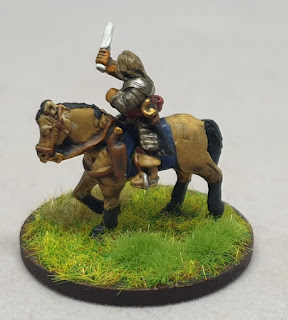Three more Royalist commanders, these were part of the package of figures that were listed as in absentia for a goodly while.
First up Sir Ralph, Lord Hopton. My first use of my new russetted armour paint recipe. I hope that you have noticed that I've tried to give him the correct colour hair (according to his portraits), otherwise all that effort will be for nought.
Regular readers (hello both of you) will know that we have already met Sir Ralph here on KeepYourPowderDry before: his story epitomises the notion of 'England tore asunder' as his opponent in battle was invariably his good friend Sir William Waller.
As a 21 year old Hopton undertook the C17th equivalent of a gap year, but instead of travelling to 'find himself' his goal was to 'learn languages'. Finding himself caught up in the Thirty Years War he joined a volunteer English force fighting for Frederick of the Palatinate (whose sons Rupert and Maurice we know quite well). He, and his good friend William Waller, were part of the group that escorted Frederick and his wife Elizabeth (who just happened to be Charles I's sister) from the battlefield of White Mountain.
Ralph returned to London and became an MP. During the turbulent time that he was a member of Parliament he seems to have been a moderate. In March 1642 he was sent to the Tower of London for objecting to Parliament censuring the King.
Prior to Edgehill, Hopton was made commander of the Trained Bands in the West Country, eventually raising volunteer army in support of the King. He would later rise to be lieutenant-general of the western army early in 1646.
Following the collapse of the Royalist cause, Ralph found himself in exile in the Low Countries. He was to die in Bruges, of fever, in 1652.
Next up is Sir Charles Lucas (look at the hair! Again based upon his portraits).
Lucas learned his soldiering during the Bishops' Wars where he was a troop commander in his brother's regiment. He was appointed governor of Richmond, Yorkshire, and would go on to serve with Prince Rupert at the outbreak of the First Civil War. On Rupert's recommendation he was appointed lieutenant-general of horse in Newcastle's Army. At Marston Moor he was wounded and taken prisoner; it is said he helped to identify the notable Royalist dead for burial and wept at the numbers of men slain.
Lucas benefitted from a prisoner exchange, and he became governor of Berkeley Castle, which was besieged by Rainsborough. In 1646, Lucas was second-in-command to Sir Jacob Astley in the final Royalist campaign of the First Civil War. He was taken prisoner at Stow-on-the-Wold then released after giving his parole not to bear arms against Parliament in the future.
During the Second Civil war he took command of Royalist forces in Essex, holing himself and his men up in Colchester. After a bitter and bloody siege Sir Charles was captured and shot by firing squad.
Finally Henry Tillier; alas no portraits of Tillier that I could find, so he has been given a lobster pot helmet with open visor.
He took part as a junior officer in Charles's military expeditions to Cadiz and La Rochelle in the 1620s before he takes a number of roles in the London Trained Bands in the 1630s. Initially made Captain-Leader of the Military Company of Westminster, then Captain-Leader of the Society of the Artillery Garden, precursor of the 'Honourable Artillery Company'.
The outbreak of war sees Tillier rise up the ranks; he becomes Comptroller of the Ordinances of Berwick during the Bishops' wars; he heads off on campaign to Ireland as Lieutenant-Colonel in Hunckes Regiment, before taking command of his own regiment in 1643. With the cessation in Ireland and the outbreak of the First Civil War where he becomes Quarter-Master General in Prince Rupert’s Army.
Taken prisoner at Marston Moor (by now he has made the rank of Sergeant-Major General) he is imprisoned in The Tower of London, where he has his skull fractured by his gaoler. When he recovers, he too benefits from a prisoner exchange: he was exchanged for Sir Robert Pye.
Tillier returns to the army as Sergeant-Major General and fights at Naseby. He escapes the battlefield and was present at the second siege of Bristol before ending up in Oxford, where he is one of the signatories of the Royalist surrender.
In 1647 Tillier bought a plantation in Antigua where he died three or four years later.
If you enjoyed reading this, or any of the other posts, please consider supporting the blog. Thanks.








.jfif)





Comments
Post a Comment